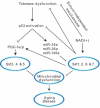Telomeres and sirtuins: at the end we meet again
- PMID: 31528700
- PMCID: PMC6736325
- DOI: 10.1080/23723556.2019.1632613
Telomeres and sirtuins: at the end we meet again
Abstract
Telomeres and sirtuins are independently implicated in causing disease and aging, but how they cooperate is not well understood. A recent study demonstrates that telomere shortening represses sirtuins and increasing sirtuin activity stabilizes telomeres and improves telomere-dependent disease, suggesting that these two pathways are tightly intertwined.
Keywords: NAD(+); Telomeres; aging; damage; disease; p53; sirtuins.
Figures

References
-
- Guarente L. Sir2 links chromatin silencing, metabolism, and aging. Genes Dev. 2000;14:1021–1026. - PubMed
Grants and funding
LinkOut - more resources
Full Text Sources
Research Materials
Miscellaneous
